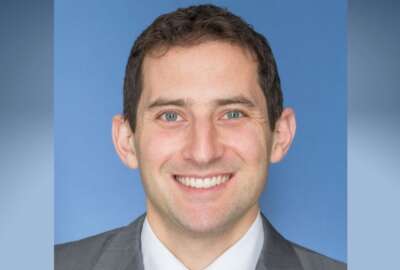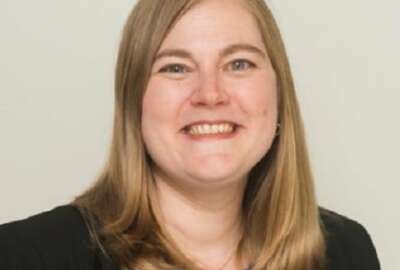Hubbard Radio Washington DC, LLC. All rights reserved. This website is not intended for users located within the European Economic Area.
How to get smart college students to help your agency solve big challenges
A bill in Congress would make it easier for all agencies to use the program coordinated by a nonprofit called Common Mission Project.
Best listening experience is on Chrome, Firefox or Safari. Subscribe to Federal Drive’s daily audio interviews on Apple Podcasts or PodcastOne.
What if you had 100 colleges and universities focusing on your agency’s top challenges? That’s the idea behind a program called “Hacking for …” — name your mission. Public administration challenges get translated into semester long courses and various schools, and the results get delivered back to the original agency. Now a bill in Congress would make it easier for all agencies to use the program coordinated by a nonprofit called Common Mission Project. Executive Director Alex Gallo talked to the Federal Drive with Tom Temin.
Interview transcript:
Tom Temin: And before we get into this bill, just tell us more about Common Mission Project. You’re kind of a connector I gather between smart kids and professors that want to help, and agencies that have big problems they can’t solve.
Alex Gallo: Yeah, you’re absolutely correct. So the Common Mission Project is a 501(c)(3) nonprofit. We have affiliates, both in the United States and the United Kingdom, and in Australia. And we’ve run these hacking for university programs at now over 50 universities in the United States and 75 globally. And the nature of it is we bring together the government, universities and the private sector around these critical public problems. Students form interdisciplinary teams, and they leverage entrepreneurship and innovation methods to solve those problems. It’s gained a lot of traction within the government, and we’re really excited to see senior leaders and on the Hill and the executive branch. I should also mention that we do this with our government partners at DOD, the national security innovation network, which leads the national program, DHS S&T, and at Department of State we do it with their International Security and Nonproliferation Bureau.
Tom Temin: And give us an example just to illustrate a type of project or challenge that might come before you, how do you get to the right hands and then what happens?
Alex Gallo: So what we do is we source problems, everything from the warfighter level or the end user level all the way up to the policy level and everything in between that you can imagine, everything from, as I said, warfighting problems to organizational change problems to strategy and policy problems. And one great example that we often talk about was a team at Stanford University in 2016, called Team Capella. This team was working on an Air Force Intelligence Surveillance and Reconnaissance problem. And in short, not only did they validate the problem, they solved the problem. And the Air Force recognized that there wasn’t an entity in the defense space to actually service a solution. So Team Capella formed a company now known as Capella Space. And they do synthetic aperture radar satellites that are really disrupting and supporting the Department of Defense mission. And so today, if you were to turn on the news and watch open source imagery coming out of Ukraine, Capella Space is one of those companies that you’ll see providing that imagery, and it’s really transforming national security space.
Tom Temin: And you mentioned the State Department, which has probably less hardware type of problems and more, I guess, policy, programmatic challenges. Give us an example of what might be going on there that is facilitated by Common Mission Project.
Alex Gallo: You’re absolutely right. Yeah, so those are often more policy-based problems. One great example, another one is a team that called themselves a student team, all the student teams name themselves and this team was called “Vera.” They were working on an issue between Libya and Tunisia, having to do with making sure that they can monitor the border for illicit trafficking and such. And they worked on this with the U.S. Department of State, but also Libyan customs and Tunisian customs. And actually, they went they traveled to Tunisia, to present their findings to both sides, which is actually another example of the power and the international reach these programs have.
Tom Temin: Sounds like they should work with DHS on our border and smuggling with all the fentanyl coming in.
Alex Gallo: Absolutely. And on that point, we have had those type of problems in Hacking for Defense. We have one example of Texas A&M, where we had a problem where they were looking at illicit trafficking as you noted crossing the border. The students identified, they zeroed in on the fact that folks on the other side of the border, the traffickers are actually using drone technology to go over the border. And they zeroed in on that and actually came up with a solution, which is a technical solution, a passive radar monitoring ability to help our border agents.
Tom Temin: Interesting. We’re speaking with Alex Gallo, he’s executive director of Common Mission Project. And the hacking lasts the length of a semester, and it’s a credit course for the students involved?
Alex Gallo: That’s correct. Yes. So every student across the United States takes it for credit. It’s towards their degree program. And every student team I should note, has their own problem and their own government sponsor. So we’re sourcing upwards of 200 problems a semester right now, and injecting them into these undergraduate- and graduate-level courses across the United States.
Tom Temin: And how many institutions are involved?
Alex Gallo: Right now? It’s over 50. And we have actually run the program at about 60 universities in the United States to date.
Tom Temin: And you mentioned there’s also corporate involvement here. How does that work?
Alex Gallo: So the government, the U.S. government, particularly DoD, DHS, and State right now, they fund the core elements of the program and they are the government sponsors, but as you noted, private sector is involved in the course and this is a critical element because we wanted to bring together universities, government and private sector. So entities like Lockheed Martin, for example, has provided money to support student teams’ travel as they go through the discovery process. So they can meet with their sponsors and actually understand the pain points of their sponsors in an intimate way. Again, our core theory of the case is that this is an end-user focused approach, rather than sitting in the ivory tower, a traditional requirements process approach. And they support student teams and prototyping and should student teams, foreign companies, we’re also able to provide them grants to move over what I call the first valley of death, which is where your student team just formed a company. And you’re going to the next step in terms of validating your minimum viable product, and so on.
Tom Temin: So there’s an additional value then for the agency, because there’s nothing more fulfilling than describing a problem and a challenge in person to people, in effect, you’re almost mentoring at the same time, you’re getting help from.
Alex Gallo: Exactly. These corporate entities across the board, Anduril’s another one, others have tremendous subject matter expertise. So they’re certainly mentoring the teams. And the other thing I should flag is the money coming from corporates actually go towards also helping us support diversity, equity and inclusion into the course where we’re recruiting nontraditional, women and minorities and other nontraditional institutions have not been involved in the course yet, such as HBCUs and MSIs into the program.
Tom Temin: Got it. And what is the deliverable that actually comes back to the agencies that have papers, that have thesis or what, or drones, in one case?
Alex Gallo: Possibly, yeah, and so it ranges, what you described, and just add some specificity at a minimum, this course is a problem validation course. So at a minimum, the government can expect to validate their problem. And the reason why that’s critical is, one, the government often is well known for coming up with solutions in search of problems. So this is not the problem-based approach of hacking for programs. It’s not just an analytical point, it’s also philosophical point. The second thing is the government can expect potential solution pathways. A lot of the times the students come up with minimum viable products. And then three, yes, in certain cases, students can get as far as prototyping. And we have had examples of that. Another example is a team called Aqua Link, that actually prototyped an ability for U.S. Navy SEALs to take in GPS data in a passive way so that they can more efficiently navigate to the objective and back when they’re on mission. All the above are possible.
Tom Temin: And at the top, we mentioned, there’s a bill in Congress that would make it easier for agencies to use the program. Tell us about that.
Alex Gallo: Yeah, so this is a an amendment to the FY 23 National Defense Authorization Act by Rep. [Chrissy] Houlahan (D-Pa.). We’re super excited about this, because this is exactly what the government needs. It’ll provide federal employees more opportunity across the interagency to get their problems into this type of program. And this program is a strategic innovation capability for the U.S. federal government. So we’re really excited that this would lower the barriers to entry I think for agencies such as Department of Energy, or Department of Commerce, or EPA and so on to get involved in such a program.
Copyright © 2024 Federal News Network. All rights reserved. This website is not intended for users located within the European Economic Area.
Tom Temin
Tom Temin is host of the Federal Drive and has been providing insight on federal technology and management issues for more than 30 years.
Follow @tteminWFED





